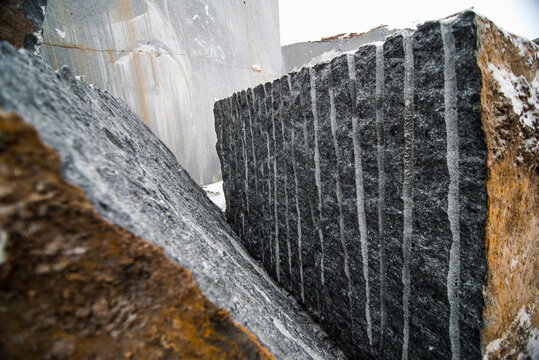The Surprise Treasures: Discovering Granite Quarries in South Africa
The Surprise Treasures: Discovering Granite Quarries in South Africa
Blog Article
Revealing the Mysteries of Granite Quarrying: Where Toughness and Elegance Meet
The world of granite quarrying is a realm where the raw stamina of nature merges with human artistry to create structures that stand the examination of time with an air of style. From the midsts of quarries to the meticulous polishing in workshops, the process of transforming granite into architectural wonders is an intricate dancing of practice and innovation. As we peer into the depths of this ancient craft, we begin to discover the concealed details that form the very essence of our developed atmosphere.
The Beginnings of Granite Quarrying
In the record of architectural history, the origins of granite quarrying are shrouded in a tapestry of ancient craftsmanship and geological marvels. Dating back to ancient Egypt and Mesopotamia, the extraction of granite from quarries marked the start of a journey that would at some point lead to the development of several of the world's most legendary frameworks.
Granite quarrying's origins can be traced to the skilled craftsmens that identified the rock's longevity and visual allure. With a combination of primitive tools and sheer determination, these very early quarry employees uncovered granite blocks that would certainly end up being the foundation of worlds.
As worlds evolved, so did the techniques of quarrying granite. The Romans, renowned for their design expertise, established sophisticated techniques for removing granite to construct monoliths, holy places, and roadways that stood the test of time.
The legacy of these old quarrying methods continues to form contemporary architecture, with granite continuing to be a sign of strength and elegance in construction jobs around the globe. (granite quarries in south africa)
Devices of the Quarrying Trade
The evolution of granite quarrying strategies from ancient civilizations to modern-day times highlights the important function played by the tools of the quarrying sell shaping the sector's methods. In old times, quarrying tools were rudimentary, usually containing chisels, hammers, and wedges made from products like bronze or iron. These devices needed significant workforce and time to extract granite obstructs from quarries.

In addition, the intro of pneumatically-driven devices and high-powered equipment has substantially minimized the physical labor called for in quarrying operations, improving worker safety and productivity. As the quarrying industry remains to introduce, the tools of the trade remain at the forefront of driving progression and forming the future of granite removal.
Removing Blocks of Granite
Using accuracy equipment and advanced strategies, the extraction of granite blocks from quarries has actually become a sophisticated procedure in the contemporary quarrying market. Controlled blasting techniques are after that employed to break apart the granite right into workable areas.

Sprucing Up and Finishing Strategies
To attain a perfect surface area on granite blocks, knowledgeable artisans use a collection of meticulous polishing and ending up strategies. After the Recommended Site initial extraction and forming processes, the granite obstructs undergo an extensive sprucing up phase to boost their natural elegance and toughness. One common technique made use of in polishing granite is ruby abrasion, where industrial rubies are used to grind and polish the rock to a smooth finish. This procedure not just produces a glossy surface however additionally guarantees harmony in color and structure throughout the granite block.
In addition to sprucing up, ending up strategies are put on additional fine-tune the granite's look. These techniques may include flaming, refining, or cleaning, each offering unique textures and surfaces to fit various visual choices. Flaming, for example, entails exposing the granite surface to high temperatures to create a rough, textured surface, suitable for exterior applications where slip-resistance is crucial. Honing, on the other hand, provides a matte finish that is smooth to the touch, ideal for indoor counter tops and floor covering. By carefully choosing and applying these brightening and ending up techniques, artisans can transform raw granite obstructs right into exquisite pieces that showcase both toughness and style. their website

Environmental Influence and Sustainability
With the expanding emphasis on environmental consciousness in the market, granite quarrying techniques are increasingly scrutinized for their effect on natural sources and lasting sustainability. In addition, the transport of granite from quarries to refining centers generates carbon emissions, even more contributing to environmental deterioration.
To alleviate these influences and make certain sustainability in granite quarrying, sector stakeholders are adopting various measures. Executing sophisticated innovations to minimize energy usage and water usage, recovering quarried land for environmental remediation, and promoting accountable sourcing methods are some techniques being employed. Certifications such as the Woodland Stewardship Council (FSC) and the Management in Energy and Environmental Design (LEED) help customers determine ecologically friendly granite items.
Conclusion
Finally, granite quarrying is a process that calls for specialized tools and techniques to remove blocks of granite and polish them to a high degree of finish. While the ecological effect of quarrying can be substantial, efforts are being made to boost sustainability methods in the industry. Generally, granite quarrying is a delicate balance in between taking advantage of the strength and sophistication of this natural rock while minimizing its effect on the environment.
Report this page